Grafting is a technique useful for agriculture and gardening. It involves cutting stems or branches from different species of plant and connecting them together, bringing out their useful characteristics. Combining plants has major advantages: it makes them more resilient against illness, harmful insects, and injury by continuous cropping, and changes harvest times. It makes good use of plants' excellent capacity for repair, but while the method is widely known, the mechanism was not well understood. In this context, a research group from Nara Institute of Science and Technology (NAIST) and other institutions has been working to clarify this mystery, discovering key switch genes and hormones.
Why does a callus form on the cut site?
To give an example, grafting into a cut on the hypocotyl (the stem between the roots and the cotyledons (seed leaves)) of a cucumber or pumpkin is widely practiced. Connecting different species may seem a little rough, but if done properly the plants will get through the ordeal. A mass of undifferentiated cells known as a callus, forms on the cut sites, filling them and connecting them together. The callus is eventually able to differentiate into cells that create various tissues, including vascular bundles through which water and nutrients travel. So through what mechanism do plants that have been cut and stimulated form a callus and join together?
A research group consisting of Momoko Ikeuchi, Associate Professor of the Graduate School of Science and Technology, NAIST (plant embryology, Associate Professor of the Faculty of Science, Niigata University until March 2022) and her colleagues investigated the activity of genes in thale cress, a model plant widely used for experiments. Among these, they focused on WOX13, a gene that becomes active soon after the plant is cut. WOX13 is a kind of transcription factor, which serves as a switch for other genes. It's widely possessed by terrestrial plants, so it was expected to have an important role of some sort. In bryophytes (mosses), it is a key existence in enabling stem cells to form when a leaf is cut, but its role in spermatophytes (seed plants) was not understood.
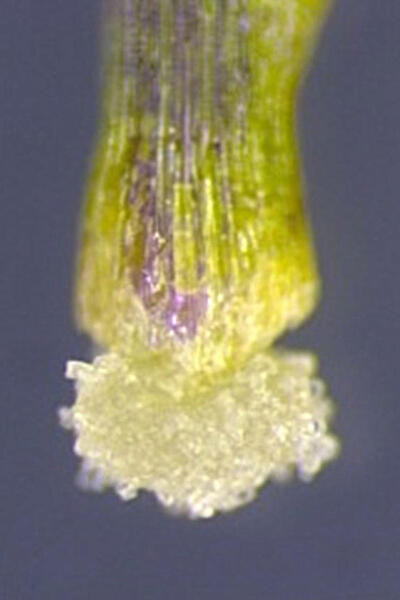
(provided by NAIST).
From this background, the group first investigated mutants in which WOX13 is not active and found that the callus was remarkably small and large cells in particular had vanished. The organs did not join at all. In other words, the group learned that WOX13 is necessary for the cut sites to stick.
They also found that WOX13 and the WIND gene group, key to body regeneration, affect each other, and that WOX13 activity affects the genes that control polysaccharide (the material of cell walls) degradation and cell elongation. The stimulus of being cut activates WOX13, which enables the differentiation of a variety of cells in an undifferentiated state, and the reformation of cell walls. In this way, the group discovered that the transcription factor WOX13 governs callus formation and cut-site adhesion.
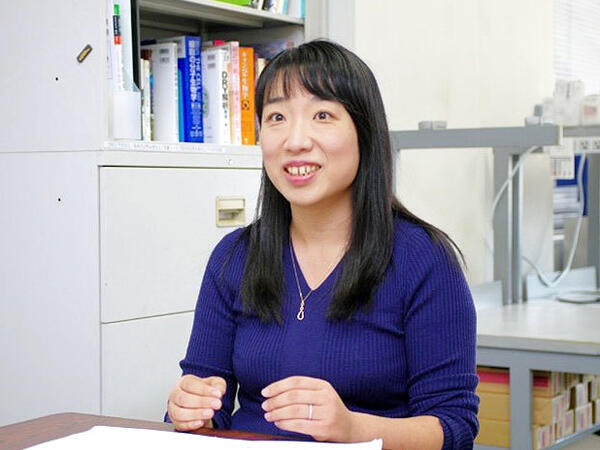
NAIST, Ikoma City, Nara Prefecture
These outcomes were published in the electronic version of the American journal Plant Physiology, and announced by research group members Niigata University, RIKEN, Meijo University and Chubu University in November 2021.
Focusing on the 'one-way' hormone, auxin
Ikeuchi and her colleagues continued this research further. Plants contain a key hormone that enables cell growth: auxin. Auxin travels in one direction, from the leaves to the roots, so when a plant's body is wounded for grafting, how does this hormone behave?
While engaging in research with students at Niigata University, Ikeuchi suddenly noted that the callus that formed after cutting the petiole, the rod-shaped part of thale cress that connects the leaves and stems, had a prominent characteristic. Although a callus actively formed on the top part of the cut site, it was clearly hard for it to form on the bottom part. The stimulus of being cut should have been the same on the top and bottom part of the cut site. And yet there was this difference - was this because something was different between the top and bottom of the petiole?
When the group researched this, they found that three hours after the petiole was cut, auxin concentration increased more on the top part of the petiole. If you consider that auxin travels in one direction, this outcome is within the scope of prediction, but as Ikeuchi pointed out, "Hormone quantities are controlled in various ways, and it was difficult work proving this." Moreover, the genes that activate in response to auxin were quite active on the top part.
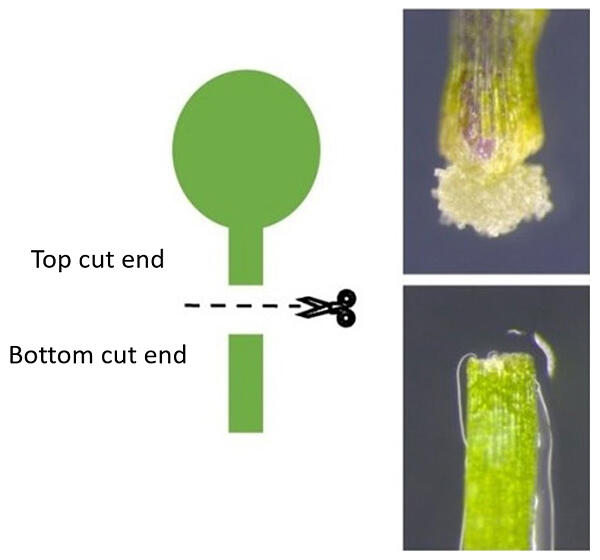
(provided by NAIST and translated by Science Japan)
When the group used a drug that blocked auxin's one-way travel, the callus on the top part struggled to form. Conversely, when they coated the bottom part with auxin, a callus actively formed, similar to the top part. These outcomes showed that a difference in auxin quantities was behind the differences between the top and bottom parts.

(provided by NAIST and translated by Science Japan)
The group also investigated the involvement of WOX13. WOX13 became active whether auxin was given to an uninjured plant or to a cut petiole. When the leaves were treated with a drug that obstructs auxin's one-way transport, WOX13 activity in the top part of the petiole slowed dramatically. Thus, the group discovered that WOX13 works actively in the top part of the cutting due to a build-up of auxin.
These outcomes were published in the electronic edition of Plant and Cell Physiology, the international journal of the Japanese Society of Plant Physiologists, on October 20, 2022, and announced by NAIST, Niigata University, Teikyo University and RIKEN.
Contributing to further clarification and food supply issues
Based on this series of outcomes, Ikeuchi and her colleagues have proposed the following mechanism:
(1) The plant is stimulated when the organ is cut.
(2) The auxin that travels from the leaves to the roots accumulates in the top part of the cut site, while it is reduced in the bottom part.
(3) WOX13 is particularly strongly active in the top part, where the stimulus of being cut and auxin is increased, and a callus actively forms.
Finally, the cells of the callus site differentiate, and the cut surfaces join.
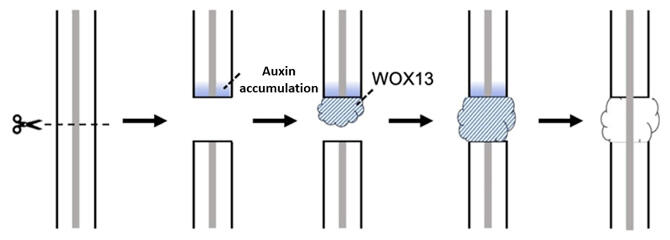
(provided by NAIST and translated by Science Japan)
WOX13 holds the key to body repair in flowering plants such as thale cress, as well as bryophytes, which have been investigated in previous research. The fact that WOX13 is widely maintained in terrestrial plants even through repeated evolution has increased the understanding that this is a key gene for repair. Ikeuchi is also very interested in this and is currently looking into it.
The mystery of the series of phenomena that enable the formation of a callus, triggered by the stimulation of being cut, is mostly solved. However, the detailed mechanism through which the cells that receive auxin signals activate WOX13 and the more detailed workings of WOX13 remain as future research topics.
Plants cleverly repair their bodies, with a vitality for life. If we can further our understanding of this mechanism and increase our knowledge of grafting, this has the potential to be useful in agriculture and gardening, and may contribute to food supply issues, which are an increasing concern worldwide.
Ikeuchi commented, "How universal is what we have learned through the thale cress experiments? This is very interesting in terms of basic science. At the moment, we are concentrating on clarifying the mechanism, but I think it would be wonderful if we could make agriculture more efficient by increasing the regenerative capabilities of various crops." In November 2021, Ikeuchi was selected for the Japan Science and Technology Agency's (JST) FOREST Program. Her research topic is "Clarifying Cell Fate Determination and Self Organization Mechanisms in the Plant Organ Formation Process."
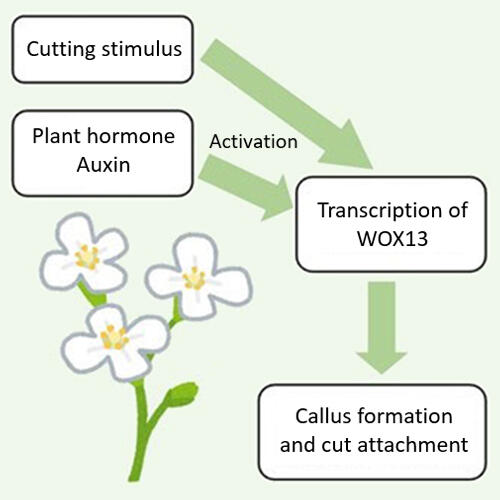
(created based on the article)
Wonderous vitality: the ability to "make a fresh start"
"Even though they don't move and seem weaker than animals, they flourish," says Ikeuchi, who has been very interested in plants since her childhood. She says she would go hiking with a picture book in hand, and her interest was especially piqued by how the different body shapes of plants are determined. Through her time as a student, she explored this in a scientific manner, and focused on cell differentiation. She chose a path of researching differentiation, reprogramming (returning to an undifferentiated state) and regeneration.
However, animal bodies also have the capacity for repair. For example, if we fall and graze ourselves, cells form on the site and it eventually heals. When Ikeuchi was asked "What is something interesting that is unique to plants?" she replied, "They can make a fresh start." She described this fascinating point: "They can rebuild their entire body from body tissue, and live. Plants can reprogram cells (return them to an undifferentiated state), and once again create order in that mass of cells, generating a normal body - it's truly a fresh start. Rather than restoration to what it was before, it's creation. It's an amazing ability."
The ability to "make a fresh start." In response to Ikeuchi's impactful statement, I thought about if people could do that too... it made me feel somewhat melancholic, so I left that to the lab. That aside, shouldn't humans continue to learn about plants' vitality, take on their survival strategies, and live even better lives? This article has ended up emphasizing this idea.
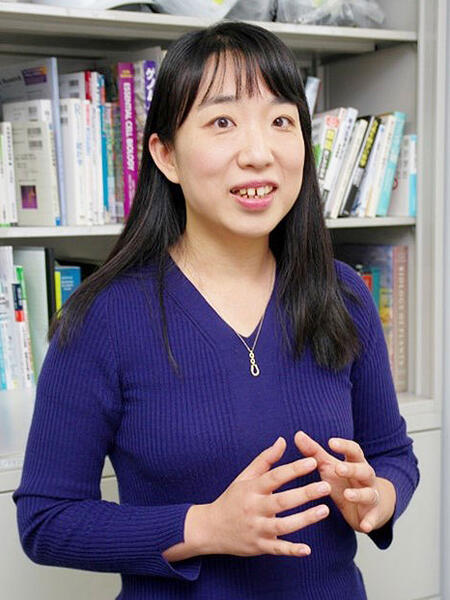
(KUSAKA Takeo / Science Portal Editorial Office)
Original article was provided by the Science Portal and has been translated by Science Japan.




